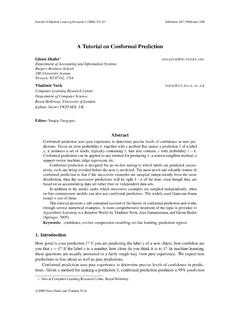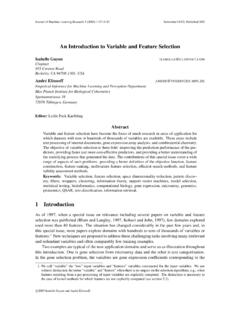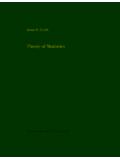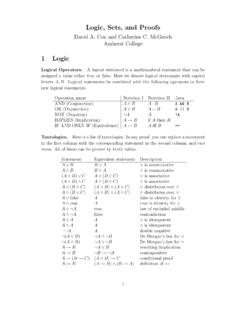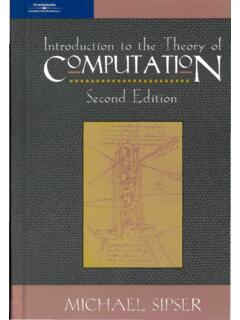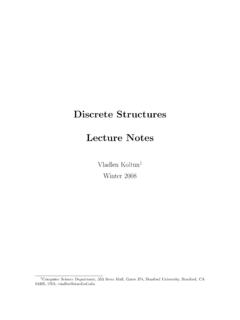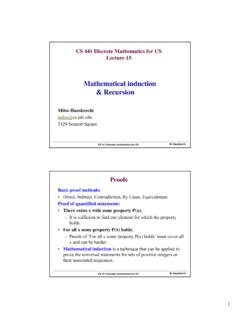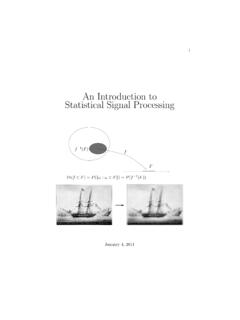Transcription of Mathematical Writing CS209. Mathematical Writing—
1 Mathematical WritingbyDonald E. Knuth, Tracy Larrabee, and Paul M. RobertsThis report is based on a course of the same name given at Stanford University duringautumn quarter, 1987. Here s the catalog description:CS 209. Mathematical Writing Issues of technical Writing and the ef-fective presentation of mathematics and computer science. Preparation of theses,papers, books, and literate computer programs. A term paper on a topic ofyour choice; this paper may be used for credit in another first three lectures were a minicourse that summarized the basics. About twohundred people attended those three sessions, which were devoted primarily to a discussionof the points in 1 of this report.
2 An exercise ( 2) and a suggested solution ( 3) were alsopart of the remaining 28 lectures covered these and other issues in depth. We saw manyexamples of before and after from manuscripts in progress. We learned how to avoidexcessive subscripts and superscripts. We discussed the documentation of algorithms, com-puter programs, and user manuals. We considered the process of refereeing and studied how to make effective diagrams and tables, and how to find appropriate quota-tions to spice up a text. Some of the material duplicated some of what would be discussedin Writing classes offered by the English department, but the vast majority of the lectureswere devoted to issues that are specific to mathematics and/or computer lectures by Herb Wilf (University of Pennsylvania), Jeff Ullman (Stanford),Leslie Lamport (Digital Equipment Corporation), Nils Nilsson (Stanford), Mary-Clairevan Leunen (Digital Equipment Corporation), Rosalie Stemer (San Francisco Chronicle),and Paul Halmos (University of Santa Clara)
3 , were a special highlight as each of theseoutstanding authors presented their own perspectives on the problems of report contains transcripts of the lectures and copies of various handouts thatwere distributed during the quarter. We think the course was able to clarify a surprisinglylarge number of issues that play an important part in the life of every professional whoworks in Mathematical fields. Therefore we hope that people who were unable to attendthe course might still benefit from it, by reading this summary of what authors wish to thank Phyllis Winkler for the first-rate technical typing thatmade these notes : These are transcripts of lectures, not a polished set of essays on the of the later lectures refer to mistakes in the notes of earlier lectures; we have decidedto correct some (but not all) of those mistakes before printing this report.
4 References tosuch no-longer-existent blunders might be hard to understand. Understand?Videotapes of the class sessions are kept in the Mathematical & Computer SciencesLibrary at preparation of this report was supported in part by NSF grant of Contents . Minicourse on technical Writing ..1 . An exercise on technical Writing ..7 . An answer to the exercise..8 . Comments on student answers (1) ..9 . Comments on student answers (2) .. 11 . Preparing books for publication (1) .. 14 . Preparing books for publication (2) .. 15 . Preparing books for publication (3) .. 18 . Handy reference books .. 19 . Presenting algorithms.
5 20 . Literate Programming (1) .. 22 . Literate Programming (2) .. 26 . User manuals .. 28 . Galley proofs .. 30 . Refereeing (1).. 31 . Refereeing (2).. 34 . Hints for Referees .. 36 . Illustrations (1) .. 37 . Illustrations (2) .. 40 . Homework: Subscripts and superscripts .. 40 . Homework: Solutions .. 43 . Quotations .. 47 . Scientific American Saga (1) .. 49 . Scientific American Saga (2) .. 51 . Examples of good style.. 54 . Mary-Claire van Leunen on hopefully .. 57 . Herb Wilf on Mathematical Writing .. 59 . Wilf s first extreme .. 61 . Wilf s other extreme.
6 62 . Jeff Ullman on Getting Rich .. 66 . Leslie Lamport on Writing Papers .. 69 . Lamport s handout on unnecessary prose .. 71 . Lamport s handout on styles of proof.. 72 . Nils Nilsson on Art and Writing .. 73 . Mary-Claire van Leunen on Calisthenics (1).. 77 . Mary-Claire s handout on Composition Exercises .. 81 . Comments on student work.. 89 . Mary-Claire van Leunen on Which vs. That.. 93 . Mary-Claire van Leunen on Calisthenics (2).. 98 . Computer aids to Writing .. 100 . Rosalie Stemer on Copy Editing.. 102 . Paul Halmos on Mathematical Writing .. 106 . Final truths.. 112 . Notes on Technical WritingStanford s library card catalog refers to more than 100 books about technical Writing ,including such titles asThe Art of Technical Writing ,The Craft of Technical Writing ,The Teaching of Technical Writing .
7 There is even a journal devoted to the subject, theIEEE Transactions on Professional Communication, published since 1958. The AmericanChemical Society, the American Institute of Physics, the American Mathematical Society,and the Mathematical Association of America have each published manuals of style. The last of these, Writing Mathematics Wellby Leonard Gillman, is one of the requiredtexts for CS nicest little reference for a quick tutorial isThe Elements of Style, by Strunk andWhite (Macmillan, 1979). Everybody should read this 85-page book, which tells aboutEnglish prose Writing in general. But it isn t a required text it s merely other required text for CS 209 isA Handbook for Scholarsby Mary-Claire vanLeunen (Knopf, 1978).
8 This well-written book is a real pleasure to read, in spite of itsunexciting title. It tells about footnotes, references, quotations, and such things, donecorrectly instead of the old-fashioned op. cit. Writing has certain peculiar problems that have rarely been discussedin the literature. Gillman s book refers to the three previous classics in the field: Anarticle by Harley Flanders,Amer. Math. Monthly, 1971, pp. 1 10; another by R. P. Boasin the same journal, 1981, pp. 727 731. There s also a nice booklet calledHow to WriteMathematics, published by the American Mathematical Society in 1973, especially thedelightful essay by Paul R. Halmos on pp. 19 following points are especially important, in your instructor s view:1.
9 Symbols in different formulas must be separated by : ConsiderSq,q < : ConsiderSq, whereq < Don t start a sentence with a :xn ahasndistinct : The polynomialxn ahasndistinct Don t use the , , , ,3; replace them by the corresponding words.(Except in works on logic, of course.)4. The statement just preceding a theorem, algorithm, etc., should be a complete sen-tence or should end with a : We now have the (x) is is bad on three counts, including rule 2. It should be rewritten, for example, likethis:Good: We can now prove the following functionH(x) defined in (5) is better would be to replace the first sentence by a more suggestive motivation,tying the theorem up with the previous discussion.
10 [ . MINICOURSE ON TECHNICAL WRITING1]5. The statement of a theorem should usually be self-contained, not depending on theassumptions in the preceding text. (See the restatement of the theorem in point 4.)6. The word we is often useful to avoid passive voice; the good first sentence ofexample 4 is much better than The following result can now be proved. But thisuse of we should be used in contexts where it means you and me together ,notaformal equivalent of I . Think of a dialog between author and most technical Writing , I should be avoided, unless the author s persona is There is a definite rhythm in sentences. Read what you have written, and change thewording if it does not flow smoothly.
